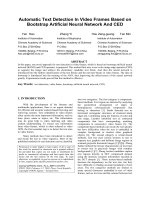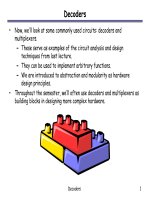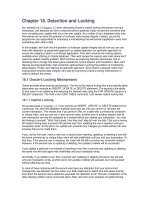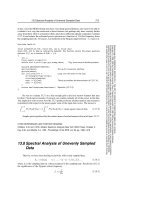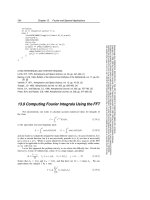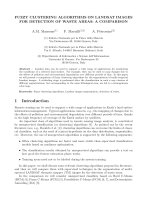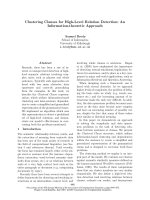07 community detection spectral clustering
Bạn đang xem bản rút gọn của tài liệu. Xem và tải ngay bản đầy đủ của tài liệu tại đây (39.8 MB, 62 trang )
CS224W: Analysis of Networks
Jure Leskovec, Stanford University
¡
Three basic stages:
§ 1) Pre-processing
§ Construct a matrix representation of the graph
§ 2) Decomposition
§ Compute eigenvalues and eigenvectors of the matrix
§ Map each point to a lower-dimensional representation
based on one or more eigenvectors
§ 3) Grouping
§ Assign points to two or more clusters, based on the new
representation
¡
But first, let’s define the problem
10/16/18
Jure Leskovec, Stanford CS224W: Analysis of Networks,
2
¡
¡
Undirected graph !(#, %):
5
1
2
4
3
Bi-partitioning task:
6
§ Divide vertices into two disjoint groups (, )
A
2
¡
3
B
5
1
4
6
Questions:
§ How can we define a “good” partition of !?
§ How can we efficiently identify such a partition?
10/16/18
Jure Leskovec, Stanford CS224W: Analysis of Networks,
3
¡
What makes a good partition?
§ Maximize the number of within-group
connections
§ Minimize the number of between-group
connections
5
1
2
3
A
10/16/18
6
4
B
Jure Leskovec, Stanford CS224W: Analysis of Networks,
4
¡
Express partitioning objectives as a function
of the “edge cut” of the partition
¡
Cut: Set of edges with only one vertex in a
group:
If the graph is weighted wij is the
weight, otherwise, all wij={0,1}
A
1
2
3
10/16/18
B
5
4
6
Jure Leskovec, Stanford CS224W: Analysis of Networks,
cut(A,B) = 2
5
¡
Criterion: Minimum-cut
§ Minimize weight of connections between groups
arg minA,B cut(A,B)
¡ Degenerate case:
“Optimal” cut
Minimum cut
¡
Problem:
§ Only considers external cluster connections
§ Does not consider internal cluster connectivity
10/16/18
Jure Leskovec, Stanford CS224W: Analysis of Networks,
6
[Shi-Malik]
¡
Criterion: Conductance [Shi-Malik, ’97]
§ Connectivity between groups relative to the density
of each group
!"#(%): total weighted degree of the nodes in
%: !"# % = ∑)∈% +) (number of edge end points in %)
n Why
n
¡
use this criterion?
Produces more balanced partitions
How do we efficiently find a good partition?
§ Problem: Computing best conductance cut is NP-hard
10/16/18
Jure Leskovec, Stanford CS224W: Analysis of Networks,
7
¡
A: adjacency matrix of undirected G
§ Aij =1 if (", $) is an edge, else 0
¡
x is a vector in Ân with components (&', … , &))
§ Think of it as a label/value of each node of *
¡
What is the meaning of A× x?
2
+, = . 3,/ 4/ = . 4/
/01
¡
,,/ ∈6
Entry yi is a sum of labels xj of neighbors of i
10/16/18
Jure Leskovec, Stanford CS224W: Analysis of Networks,
8
Ă jth coordinate of Aì
x:
Đ Sum of the x-values
of neighbors of j
§ Make this a new x-value at node j
¡
'⋅"=&⋅"
Spectral Graph Theory:
§ Analyze the “spectrum” of matrix representing !
§ Spectrum: Eigenvectors "($) of a graph, ordered by
the magnitude (strength) of their corresponding
eigenvalues &$ :
10/16/18
Note: We sort &$ in ascending (not descending) order!
Jure Leskovec, Stanford CS224W: Analysis of Networks,
9
Suppose all nodes in ! have degree "
(! is "-regular) and ! is connected
¡ What are some eigenvalues/vectors of !?
#× $ = & ⋅ $ What is l? What x?
¡
¡
§ Let’s try: $ = (), ), … , ))
§ Then: # ⋅ $ = ", ", … , " = & ⋅ $. So: & = "
§ We found an eigenpair of !:
$ = (), ), … , )), & = "
" is the largest eigenvalue of # (see next slide)
Remember the meaning of - = #× $:
Note, this is just one eigenpair. An n by n
matrix can have up to n eigenpairs.
10/16/18
4
./ = 0 5/1 61 = 0 61
Jure Leskovec, Stanford CS224W: Analysis of Networks,
123
/,1 ∈8
10
Details!
¡
¡
! is "-regular connected, # is its adjacency matrix
Claim:
§ (1) " has multiplicity of 1 (there is only 1 eigenvector
associated with eigenvalue ")
§ (2) d is the largest eigenvalue of #
¡
Proof:
To obtain value eigval " we needed $% = $' for every (, *
This means $ = + ⋅ (1,1, … , 1) for some const. +
Define: Set 1 = nodes % with maximum value of $%
Then consider some vector 2 which is not a multiple of
vector (3, … , 3). So not all nodes % (with labels 2% ) are in 1
§ Consider some node ' ∈ 1 and a neighbor % ∉ 1 then
node ' gets a value strictly less than "
§ So 6 is not eigenvector! And so " is the largest eigenvalue!
§
§
§
§
10/16/18
Jure Leskovec, Stanford CS224W: Analysis of Networks,
11
¡
What if ! is not connected?
§ ! has 2 components, each "-regular
¡
What are some eigenvectors?
C
B
§ # = Put all %s on & and 's on ( or vice versa
§ #′ = %, … , %, ', … , ' , then - ⋅ #′ = ", … , ", ', … , ' ,
|B|
|C|
§ #′′ = ', … , ', %, … , % , then / ⋅ #′′ = ', … , ', ", … , " ,
§ And so in both cases the corresponding 0 = "
¡
A bit of intuition:
C
B
01 = 012%
10/16/18
C
B
2nd largest eigval.
5627 now has
value very close
to 56
01 − 012% ≈ '
Jure Leskovec, Stanford CS224W: Analysis of Networks,
12
C
B
2" = 2")%
C
B
2" − 2")% ≈ +
2nd largest eigval.
56)7 now has
value very close
to 56
§ If the graph is connected (right example) then we already
know that !" = (%, … %) is an eigenvector
§ Eigenvectors are orthogonal so then the components of
!")% must sum to 0
§ Why? !" ⋅ !")% = + then ∑- !" - ⋅ !")% [-] = ∑- !" [-]
§ !")% “splits” the nodes into two groups
§ !")% - > + vs. !")% - < +
10/16/18
§ So we in principle could look at the eigenvector of the 2nd largest
eigenvalue and declare nodes with positive label in C and negative
label in B. (but there are still many details for us to figure out here)
Jure Leskovec, Stanford CS224W: Analysis of Networks,
13
¡
Adjacency matrix (A):
§ n´ n matrix
§ A=[aij], aij=1 if edge between node i and j
5
1
2
3
¡
4
6
Important properties:
1
2
3
4
5
6
1
0
1
1
0
1
0
2
1
0
1
0
0
0
3
1
1
0
1
0
0
4
0
0
1
0
1
1
5
1
0
0
1
0
1
6
0
0
0
1
1
0
§ Symmetric matrix
§ Has ! real eigenvalues
§ Eigenvectors are real-valued and orthogonal
10/16/18
Jure Leskovec, Stanford CS224W: Analysis of Networks,
14
¡
Degree matrix (D):
§ n´ n diagonal matrix
§ D=[dii], dii = degree of node i
5
1
2
3
10/16/18
4
6
1
2
3
4
5
6
1
3
0
0
0
0
0
2
0
2
0
0
0
0
3
0
0
3
0
0
0
4
0
0
0
3
0
0
5
0
0
0
0
3
0
6
0
0
0
0
0
2
Jure Leskovec, Stanford CS224W: Analysis of Networks,
15
¡
2
3
4
5
6
Laplacian matrix (L):
1
3
-1
-1
0
-1
0
§ n´ n symmetric matrix
2
-1
2
-1
0
0
0
3
-1
-1
3
-1
0
0
4
0
0
-1
3
-1
-1
5
-1
0
0
-1
3
-1
6
0
0
0
-1
-1
2
5
1
2
3
¡
1
4
6
What is trivial eigenpair?
( = , − .
§ ! = ($, … , $) then ( ⋅ ! = * and so + = +$ = *
¡
Important properties of (:
§ Eigenvalues are non-negative real numbers
§ Eigenvectors are real (and always orthogonal)
10/16/18
Jure Leskovec, Stanford CS224W: Analysis of Networks,
16
Details!
(a) All eigenvalues are ≥ 0
(b) # $ %# = ∑() %() #( #) ≥ 0 for every #
(c) % = * $ ⋅ *
§ That is, % is positive semi-definite
Ă
Proof: (the 3 facts are saying the same thing)
Đ (c)ị(b): # $ %# = # $ * $ *# = #*
$
*# ≥ 0
§ As it is just the square of length of *#
Đ (b)ị(a): Let , be an eigenvalue of -. Then by (b)
# $ %# ≥ 0 so # $ %# = # $ .# = .# $ # Þ , ≥ /
§ (a)Þ(c): is also easy! Do it yourself.
10/16/18
Jure Leskovec, Stanford CS224W: Analysis of Networks,
17
¡
See next slide
for the proof.
Deriving this is
a HW problem.
Fact: For symmetric matrix M:
2
=
min
x : xT w1 =0
xT M x
xT x
(w1 is eigenvector corresponding to λ1)
¡
What is the meaning of min xT L x on G?
§ ! " # ! = ∑+&,()* #&( !& !( = ∑+&,()* ,&( − .&( !& !(
§ = ∑& ,&& !&/ − ∑
§=∑
/
(!
&,( ∈1 &
+
&,( ∈1 2!& !(
!(/
− 2!& !( ) = ∑
6,7 ∈8
96 − 97
:
Node 6 has degree ;6 . So, value 9:6 needs to be summed up ;6 times.
But each edge (6, 7) has two endpoints so we need 9:6 +9:7
10/16/18
Jure Leskovec, Stanford CS224W: Analysis of Networks,
18
2
¡
¡
¡
=
min
x : xT w1 =0
xT M x
xT x
Details!
Write ! in basis of eigenvecs "# , "% , … , "' of (. So,
! = ∑'+ ,+ "+
Then we get: -! = ∑+ ,+ -"+ = ∑+ ,+ .+ "+
43 73
So, what is /0 (/?
= = if 3 ≠ ?
/0
§ ! 1 -! = ∑+ ,+ "+
(/
1
∑+ ,+ .+ "+
1 otherwise
= ∑+2 ,+ .2 ,2 "+1 "2
= ∑+ ,+%.+ "+1 "+ = ∑3 43 563
§ Want minimize this over all unit vectors 7:
7 = min over choices of (,#, … ,' ) so that:
where ∑,+% = 1 (unit length) ∑,+ = 0 (orthogonal to 7< )
§ To minimize this, set 56 = < and so ∑3 43 563 = 46
10/16/18
Jure Leskovec, Stanford CS224W: Analysis of Networks,
19
2
¡
=
min
x : xT w1 =0
xT M x
xT x
What else do we know about x?
§ ! is unit vector: ∑# !$# = &
§ ! is orthogonal to 1st eigenvector (&, … , &) thus:
∑# !# ⋅ & = ∑# !# = ,
¡
Remember:
l2
å
= min
All labelings
of nodes - so
that ∑./ = 0
( i , j )ỴE
å
( xi - x j )
i
2
i
x
We want to assign values !# to nodes i such
that few edges cross 0.
(we want xi and xj to subtract each other)
10/16/18
2
i
j
x
./
Jure Leskovec, Stanford CS224W: Analysis of Networks,
0
.1
Balance to minimize
20
Back to finding the optimal cut
Express partition (A,B) as a vector
+& "( " ∈ *
!" = $
−& "( " ∈ +
¡ Enforce that |A| = |B| à ,"!" = ¡
¡
§ Equivalent to being orthogonal to the trivial eigenvector (&, … , &)
¡
We can minimize the cut of the partition by finding
a vector y that minimizes:
arg
min
<∈ =>,?> @
A(2) = B 23 − 25
3,5 ∈C
Can’t solve exactly. Let’s relax ! and
allow it to take any real value.
10/16/18
D
23 = −1 0
Jure Leskovec, Stanford CS224W: Analysis of Networks,
j
25 = +1
21
2
=
min
x : xT w1 =0
xT M x
xT x
Slide 18
y R
min
n
:
i
yi =0
∑3 637 = 1
f (y) =
(i,j)
yj )2 = y T Ly
E (yi
i
13
n
0
j
x
14
!" = $%& ( ' : The minimum value of ((') is given by
'
the 2nd smallest eigenvalue λ2 of the Laplacian matrix L
n
n
10/16/18
+ = ,-. $%&/ ( ' : The optimal solution for y is given
by the corresponding eigenvector 0, referred to as the
Fiedler vector
Can use sign of 12 to determine cluster assignment of
node 2
Jure Leskovec, Stanford CS224W: Analysis of Networks,
22
Details!
¡
Suppose there is a partition of G into A and B
where ! ≤ |$|, s.t. “conductance” of the cut
(# )*+), -./0 1 2/ 3)
(A,B) is % =
then 56 ≤ 2%
1
Note: |A|<|B|
§ This is the approximation guarantee of the spectral
clustering: Spectral finds a cut that has at most twice the
conductance as the optimal one of conductance %.
¡
Proof:
§ Let: 8 = |9|, ; = |<| and = = # edges from A to B
§ Enough to choose some >? based on A and B such that:
@A ≤
10/16/18
∑ CD ECF
∑D CDG
G
≤ 2H
(while also ∑I JI = 0)
56 Jure
isLeskovec,
onlyStanford
smaller
CS224W: Analysis of Networks,
23
Details!
¡
Proof (continued):
&
−
§ 1) Let’s set: !" = $ '&
+)
"* " ∈ ,
"* " ∈ -
Note: |A|<|B|
4
§ Let’s quickly verify that ∑/ 0/ = 0: 3 − 5 + 6
§ 2) Then:
G
10/16/18
4
5
+
4
7
∑ 9: ;9<
∑: 9:=
≤G
4
5
=
=
+
4
5
A A =
∑:∈>,<∈@ C
B D
A =
A =
5 ;
C7
D
B
J
= I ≤ JK
'
e … number of edges between A and B
=
4
7
A A =
E⋅ C
D B
A A
C
D B
=8
=
Which proves that the cost
achieved by spectral is better
than twice the OPT cost
Jure Leskovec, Stanford CS224W: Analysis of Networks,
24
Details!
¡
Putting it all together: The Cheeger inequality
!"
≤ (" ≤ "!
"#$%&
§ where )*+, is the maximum node degree
in the graph
§ Note we only provide the 1st part:(" ≤ "!
§ We did not prove
!"
"#$%&
≤ ("
§ Overall this always certifies that (" always gives a
useful bound
10/16/18
Jure Leskovec, Stanford CS224W: Analysis of Networks,
25

